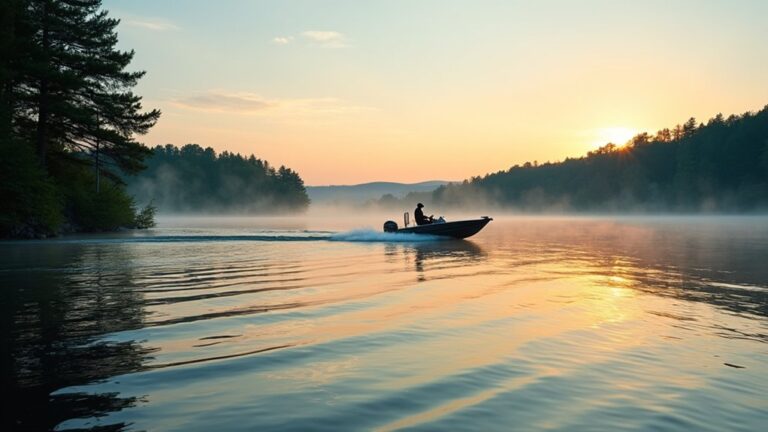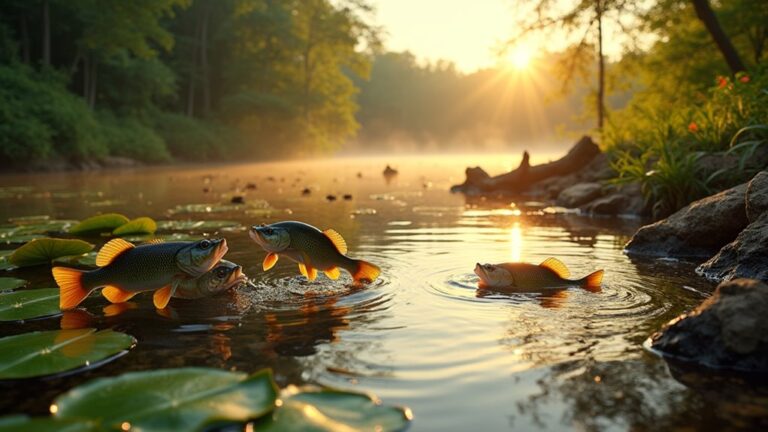To effectively map trout habitats year-round, you'll need to track their seasonal patterns. In spring, look for spawning grounds in cold, clear waters with loose gravel beds. During summer, locate deep, shaded pools where trout escape the heat. Fall brings them to shallower feeding zones near structural elements like fallen trees, while winter finds them in deep, slow-moving pools protected from freezing temperatures. Focus on water temperatures between 34-67°F, and identify natural cover like rock formations and overhanging vegetation. Understanding these seasonal movements helps pinpoint prime locations, but there's much more to discovering their preferred habitats throughout the year.
Spring Spawning Grounds
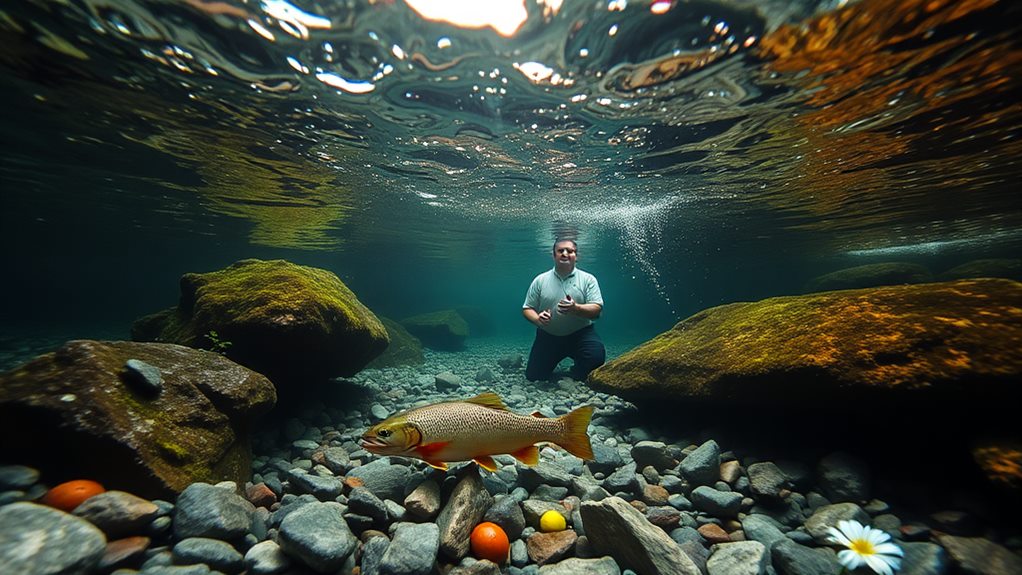
When spring arrives, trout begin their vital spawning journey, though the process actually starts in late autumn. With cold, clear waters being ideal for rainbow trout spawning at 45-60°F, females seek out these prime conditions.
Female trout seek out perfect spring spawning grounds, carefully selecting locations with loose, silt-free gravel to create their nests, called redds. You'll find these gravel nests typically containing stones between 5 and 50mm in diameter – think anywhere from pea-sized to golf ball-sized rocks.
Temperature plays a significant role in the hatching process, and you'll notice varying development times depending on water conditions. At 7.8°C, eggs hatch in about 60 days, while cooler waters of 4.7°C extend this period to 97 days.
Once hatched, the tiny alevins (they're quite adorable!) remain in their gravel habitats for 14-30 days, surviving on their yolk sacs.
As these little ones shift to fry, they'll need your help protecting their environment. Look for areas with plenty of cover – rocks, plants, and shallow waters are their best friends during this vulnerable stage.
Summer Deep Pool Locations
Throughout summer's heat, trout instinctively migrate to deep pools where temperatures remain consistently below 65°F.
You'll find these intelligent fish seeking sanctuary in areas where the current slows and the water depth increases considerably, creating their perfect summer hideaway.
These spots aren't just about staying cool – they're prime real estate for trout, complete with natural amenities like submerged rocks, fallen trees, and undercut banks.
To maximize your fishing success, you'll want to focus your efforts during the early morning or late evening hours.
That's when the trout are most active, taking advantage of the cooler periods to feed while avoiding the day's peak temperatures.
If you're serious about locating these summer hangouts, consider using a sonar or depth finder to pinpoint the deepest sections of your favorite fishing spots.
Fall Feeding Zones
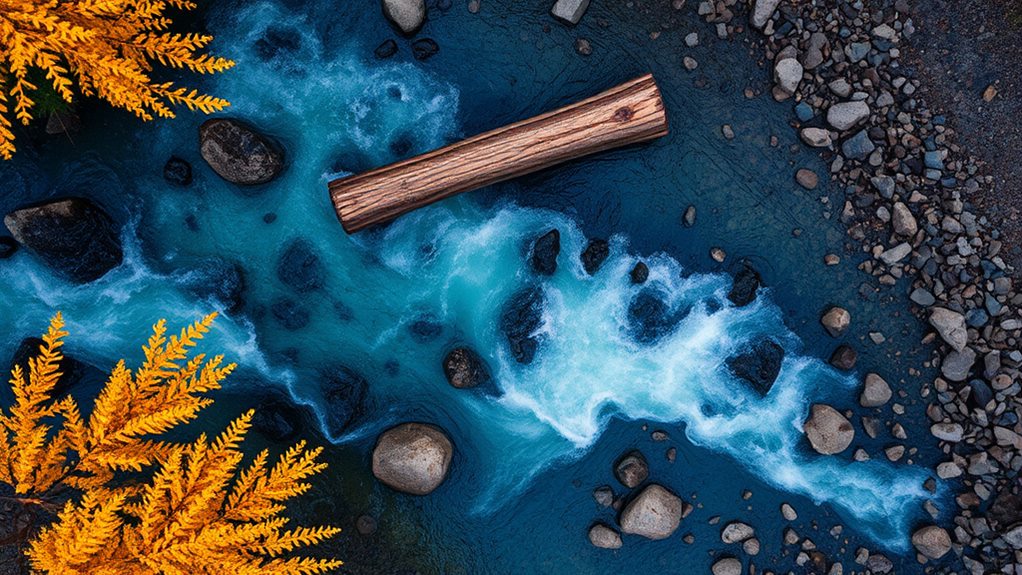
Fall's cooling waters trigger a significant change in trout behavior, drawing them into shallower feeding zones where they actively hunt for prey.
You'll find these opportunistic fish gathering near structural elements like fallen trees, rocks, and weed beds, which provide both cover and abundant food sources.
During this season, water temperatures between 50°F and 60°F create ideal conditions for increased feeding activity.
As a trout angler, you'll want to focus your attention on areas where currents slow down, particularly deeper pools and river mouths.
These spots become prime fall feeding zones as trout prepare for winter by intensifying their food intake.
You'll have the best chance of success during dawn and dusk, when trout are most active and aggressively pursuing baitfish and insects.
Key Areas to Target:
- Slower current sections near structure
- Upper layers of lakes and streams
- Changes between shallow and deep water
- Areas with congregating baitfish
Winter Holding Areas
When planning your freshwater fishing trips, focus on specific holding areas rather than casting randomly.
You'll want to target:
- Deep pools and runs
- Areas near submerged rocks
- Locations with fallen trees
- Deep holes in the riverbed
- Edges of current seams
- Protected areas near banks
Temperature Impact On Movement
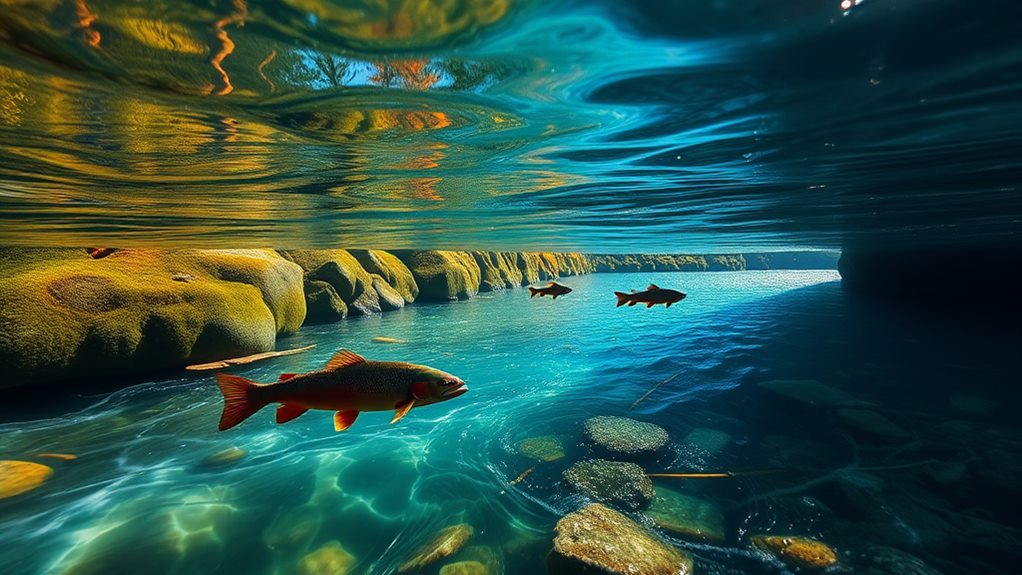
Temperature plays a pivotal role in dictating trout movement and feeding patterns throughout the day.
You'll find these fish are most active when water temperatures hover between 34-67°F, which directly affects their habitat distribution and feeding behavior. During warmer periods, especially when temperatures climb above 70°F, you'll notice trout relocating to deeper, cooler waters where they can maintain their comfort zone.
Understanding these temperature changes will help you track trout movement and improve your fishing success. In winter, they'll gather in deeper pools where temperatures remain stable, while during late spring and early summer, their increased metabolism drives them to move more frequently in search of food.
Here's what you need to know about trout behavior and temperature:
- They're most active during ideal temperature ranges, typically in morning and evening hours
- Warming waters push them toward deeper, cooler areas
- Cold temperatures concentrate them in deeper winter pools
- Their metabolism and movement increase with moderate temperature rises
- Daily temperature fluctuations affect their feeding patterns and location choices
These patterns help you predict where you'll find trout throughout the changing seasons.
Seasonal Water Flow Patterns
The seasonal flow patterns of rivers and streams create an ever-changing environment that directly shapes where you'll find trout. When you're fishing for trout, you'll need to adapt your approach as water conditions shift throughout the year.
During spring runoff, you'll discover new fishing opportunities as higher flows redistribute nutrients and create fresh feeding zones. Watch for areas where debris has been moved downstream, as these often become prime trout habitats.
Summer brings different challenges, with reduced flows forcing you to focus on deeper pools and shaded areas where trout seek refuge from warm temperatures.
Fall's increased rainfall creates excellent conditions for trout movement, and you'll want to pay attention to upstream areas where spawning occurs. As temperatures drop, follow the trout to these higher-flow sections.
In winter, you'll find most trout gathering in deeper, slower-moving waters beneath frozen surfaces.
To maximize your success, remember:
- Spring: Target newly formed pools and eddies
- Summer: Focus on deep, shaded areas
- Fall: Look upstream near spawning grounds
- Winter: Find deeper, slow-moving sections
Natural Cover Identification
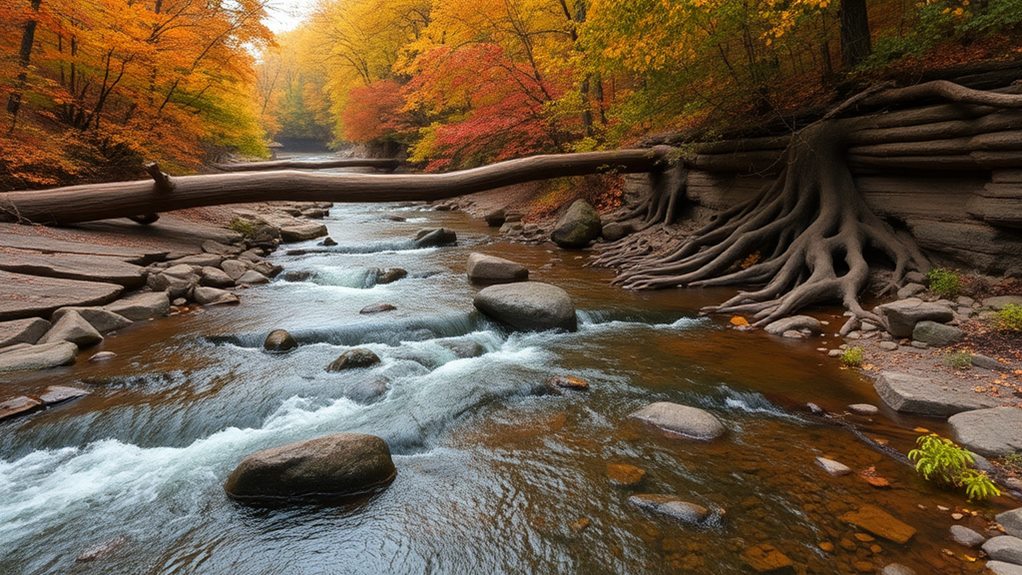
Building on your understanding of seasonal water flows, identifying natural cover will help you pinpoint exactly where trout congregate. Throughout the year, you'll notice that trout seek different types of cover based on their seasonal needs, from shallow vegetation in spring to deeper, protected pools in winter.
When you're scanning a stream or river, look for areas where natural elements create the perfect hideouts for these clever fish.
To maximize your success in finding prime trout habitats, keep an eye out for these key natural cover features:
- Rock formations and boulders that create current breaks and underwater shelters
- Overhanging vegetation and tree limbs that provide shade and protection from predators
- Submerged logs and woody debris that offer multiple hiding spots
- Undercut banks where trout can retreat during high-pressure situations
- Aquatic plant beds that attract smaller prey fish and provide concealment
Understanding these natural cover elements helps you read the water more effectively.
You'll find that trout consistently position themselves near these features, using them as staging areas for feeding and resting.
Food Source Distribution
Understanding where trout feed throughout the year gives you a significant advantage in locating prime fishing spots.
When you're planning your Trout fishing in rivers, it's essential to recognize how food source distribution shifts with seasonal changes.
In spring, you'll want to focus on areas where emerging insects and larvae are abundant, typically in warmer, shallow sections of the river.
As summer arrives, shift your attention to spots where terrestrial insects might fall into the water, like areas near overhanging branches. You'll also find trout targeting smaller fish in these warmer months.
Fall brings a significant change in feeding patterns, and you'll discover trout congregating near river mouths and lakeshores where baitfish are plentiful.
They're building up reserves for winter, so these areas become hot spots for anglers.
When winter sets in, look for deeper, slower currents where trout can conserve energy while feeding on midges and small invertebrates.
Seasonal Migration Routes
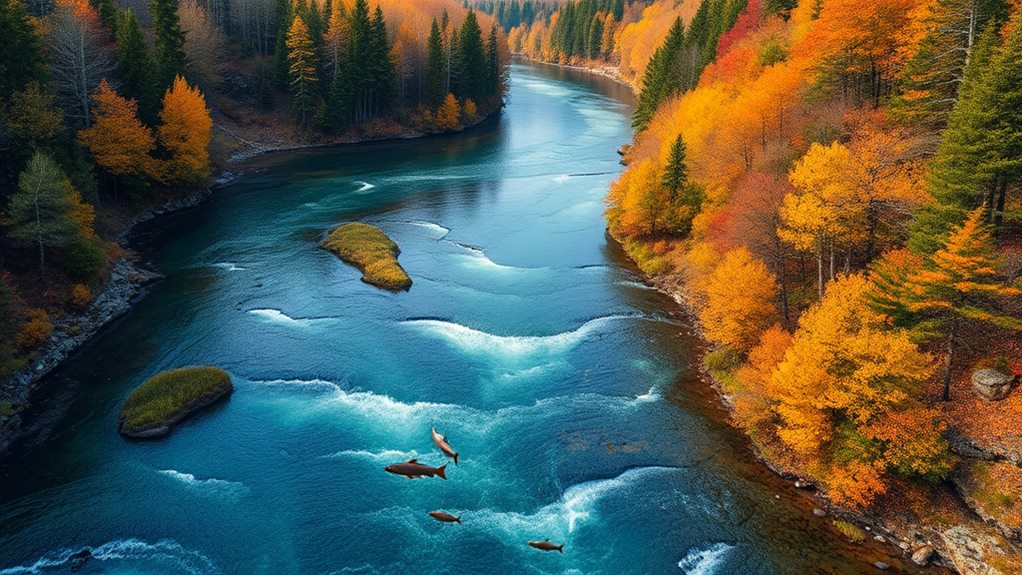
Knowing where trout feed naturally leads us to tracking their seasonal movements throughout river systems. Trout will depend on different habitats as they follow their seasonal migration patterns through the year.
You'll find them heading to freshwater streams with suitable gravel beds during winter spawning months, while they'll seek cooler, deeper waters when temperatures rise in summer.
Understanding these movements can help you locate trout year-round:
- Spring brings increased activity as waters warm above 34°F, with trout moving upstream and feeding along current lines
- Summer drives them to seek refuge in shaded areas and deeper pools to escape the heat
- Fall sees them adapting to slower waters, preparing for winter conditions
- Winter spawning periods find them in gravelly streambeds from November to January
- Year-round movements are influenced by water quality and food availability
These patterns aren't just random wanderings – they're calculated movements based on survival needs.
When you're mapping out potential fishing spots, consider how environmental factors affect their migration routes. You'll want to adjust your fishing strategy based on which part of their seasonal journey they're currently undergoing.
Critical Habitat Bottlenecks
Vital trout habitats face significant challenges when natural pathways become restricted or cut off entirely. You'll find that important habitat bottlenecks often occur when man-made structures like dams or poorly designed culverts block trout from reaching critical areas for feeding and reproduction. It's like creating roadblocks on their seasonal highways!
When you're mapping spawning habitats, look for areas with loose gravel between 5-50mm – that's what trout need for successful reproduction. However, you'll notice these prime spots aren't worth much if poor water quality or siltation makes them unusable.
Here's what to watch for:
- Barriers blocking migration routes
- Degraded water quality affecting survival rates
- Limited cover for vulnerable fry
- Insufficient food sources in nursery areas
You can help identify these bottlenecks by monitoring trout movement patterns throughout the seasons. Pay special attention to areas where populations seem to drop off suddenly – these are often indicators of habitat restrictions.
Frequently Asked Questions
What Habitat Do Trout Prefer?
You'll find trout in waters with clean gravel beds, varying depths, and plenty of cover. They need shallow areas for spawning, deep pools for resting, and structures like rocks and logs for protection.
How Old Is a 10 Inch Trout?
You'll typically find that a 10-inch trout is between 1-2 years old, though it varies by species and conditions. In rich waters, they'll reach this size faster than in harsh environments.
What Months Are Trout Most Active?
You'll find trout are most active during late spring and early summer (April-June), and again in fall (September-November). They're especially lively when water temperatures stay between 50-65°F during these peak seasons.
What Is the Hardest Trout to Catch?
You'll find Brown Trout are typically the hardest to catch, especially larger ones. They're extremely wary, feed mainly at dawn and dusk, and quickly learn to avoid artificial lures and common angling tactics.



